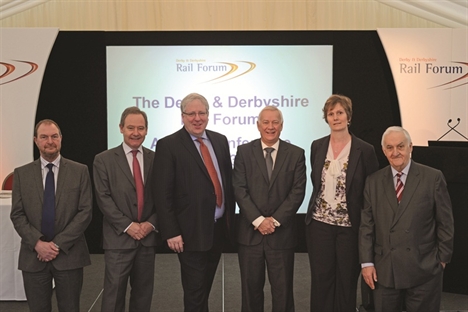28.02.13
Future forecasts
Source: Rail Technology Magazine Feb/March 2013
Richard Brown, chairman of Eurostar and author of the Brown review of franchising, spoke at the DDRF’s annual conference 2013 on the newly published Passenger Rolling Stock Strategy and its implications for the industry.
As well as his recent work on franchising, Richard Brown is currently chairing a group which has just published its fi rst report (see panel, left) on a long-term passenger rolling stock strategy for the rail industry. The group used standard industry forecasts of demand to predict future passenger numbers and how rolling stock provision should be determined over the next 30 years.
This considered the potential modal shift from car and air to rail, and how far passenger demand will continue to increase, to ensure the industry secures enough rolling stock of the right type.
One striking point made in the report is that while annual passenger km is up 91% since privatisation, there has only been a 12% increase in the size of the passenger train fleet.
Brown said: “In terms of productivity, we’re carrying lots more passengers on not many more trains. Therefore, logically, the trains are fuller than they were. Trains are getting more crowded – they’re more crowded than they ever were on some routes, because of the success [in increasing] rail passenger numbers.”
Opportunity and challenge
The forecasts will be of great value and interest to a number of players, he said, including train manufacturers and ROSCOs when working to secure investment from abroad. Train type is also specifi ed, to allow research and development to focus in the right areas. Over the next 30 years, the UK will be a “good bet for investment”, Brown said.
Growth represents a “huge challenge”, he added, and one which was not yet fully understood by the industry. “So many routes are pretty full, and if we go on growing at this rate, or anything like this rate, it’s going to get fuller. It’s going to challenge the ingenuity of everybody in the industry.”
But he added that it was also a “wonderful opportunity” for the supply chain and the industry more widely.
Meeting the challenge of rolling stock demand could involve further life extension work on the existing fl eet as well as new trains, Brown said, which could mean more work for manufacturing within the UK.
Making the case for the railways
Brown also used his speech to make the case for the UK railways in comparison with other European countries, and called for the industry to be a lot more confi dent about its progress.
“We are better than Deutsche Bahn and we shouldn’t be shy about saying it,” he stated, and considering Britain’s place in Europe, added: “The grass is not greener; it’s brown and a bit burnt.”
A higher level of confi dence throughout the industry could help persuade international players to invest in the UK and continue to boost investment and growth. Brown reiterated the necessity of investing in infrastructure to handle this projected growth in rolling stock and passenger numbers. “It’s almost a no-brainer that we need more capacity if we’re going to succeed in doubling passenger numbers over the next two or three decades.
“It isn’t just going to be about HS2. We need to make the case for HS2 and the others, rather than just HS2 or Crossrail 2 in London or something else. We’re actually going to need both if we’re going to carry those numbers of passengers.”
(Richard Brown is pictured below, second from left, alongside the other speakers at the DDRF conference. Copyright Paul Bigland. Top image: Library image, courtesy Translink NI.)

Passenger Rolling Stock Strategy
The Passenger Rolling Stock Strategy was developed by ATOC, the three ROSCOs – Angel Trains, Eversholt Rail Group and Porterbrook Leasing – and Network Rail.
The national fleet could grow by 53% to 99% over the next 30 years, the forecast indicates. The proportion of the fl eet that will be electric could rise from 68% today to 80% in 2019, with self-powered fl eets falling from 32% to 5.8%.
The group set out three different scenarios forecasting low, medium and high rates of demand for rolling stock. In the low scenario, a minimum of 13,000 new electric vehicles would be required by 2042 compared to around 8,500 today. In the medium and high scenarios the minimum total would rise to 16,000 and 19,000 respectively.
This would increase the proportion of fleet made up of electric vehicles from 68% to 90% over the period of the strategy. The increase in non-electric vehicles could be between 400 and 800.
Michael Roberts, chief executive of ATOC, said: “The boom in passenger journeys heralds a bright future for the railways” and said the strategy would help industry to prepare for that future.”
Malcolm Brown, CEO of Angel Trains, on behalf of the three rolling stock companies involved with the report, said: “This will ensure the UK has one of the youngest train fleets in Europe.”
And Paul Plummer, Network Rail group strategy director, said that the strategy marked the fi rst time long-term rolling stock implications of passenger growth and infrastructure upgrades such as electrifi cation and HS2 have been modelled and considered together. Our investment programme will increase capacity on some of the busiest part of the network, enabling more people than ever before to travel by train.”
Tell us what you think – have your say below, or email us directly at [email protected]